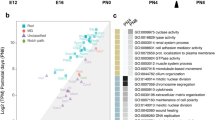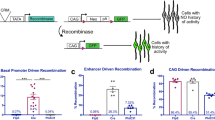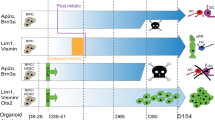Abstract
THE differentiation of multipotential progenitor cells in the vertebrate retina into photoreceptors, neurons and glial cells is regulated in part by cell-cell signalling1–11. Transforming growth factor (TGF)-7α is one of the extracellular signals implicated in the control of several aspects of retinal development, including proliferation and cell fate5,6,11–13. The way cells interpret pleiotropic signals such as TGF-α is influenced by the level of expression of epidermal growth factor receptor (EGF-R) in some cell lines14,15. To address the influence of receptor level on responses of retinal progenitor cells to TGF-α, additional copies of EGF-Rs were introduced in vitro and in vivo with a retrovirus. Normally in vitro, low concentrations of TGF-α stimulated proliferation whereas high concentrations biased choice of cell fate, inhibiting differentiation into rod photoreceptors while promoting differentiation into Müller glial cells. We report here that introduction of extra EGF-Rs into progenitor cells in vitro reduced the concentration of TGF-a required for changes in rod and Muller cell differentiation but did not enhance proliferation. Introduction of extra EGF-Rs in vivo increased the proportion of clones that contained Muller glial cells, suggesting that receptor level is normally limiting. These findings demonstrate that responsiveness to extracellular signals during development can be modulated by the introduction of additional receptors, and suggest that the level of expression of receptors for these signals contributes to the regulation of cell fate.
This is a preview of subscription content, access via your institution
Access options
Subscribe to this journal
Receive 51 print issues and online access
$199.00 per year
only $3.90 per issue
Buy this article
- Purchase on Springer Link
- Instant access to full article PDF
Prices may be subject to local taxes which are calculated during checkout
Similar content being viewed by others
References
Turner, D. L. & Cepko, C. L. Nature 328, 131–136 (1987).
Turner, D. L., Snyder, E. Y. & Cepko, C. L. Neuron 4, 833–845 (1990).
Holt, C. E., Bertsch, T. W., Ellis, H. M. & Harris, W. A. Neuron 1, 15–26 (1988).
Wetts, R. & Fraser, S. E. Science 239, 1142–1145 (1988).
Anchan, R. M., Reh, T. A., Angello, J., Balliet, A. & Walker, M. Neuron 6, 923–936 (1991).
Lillien, L. & Cepko, C. Development 115, 253–266 (1992).
Adler, R. & Hattlee, M. Science 243, 391–393 (1989).
Watanabe, T. & Raff, M. C. Neuron 3, 461–467 (1990).
Altshuler, D. & Cepko, C. L. Development 114, 947–957 (1992).
Hunter, D. D., Murphy, M. D., Olsson, C. V. & Brunken, W. J. Neuron 8, 399–413 (1992).
Reh, T. A. J. Neurobiol. 23, 1067–1083 (1992).
Leutteke, N. C. et al. Cell 73, 263–278 (1993).
Mann, G. B. et al. Cell 73, 249–261 (1993).
Traverse, S. et al. Curr. Biol. 4, 694–701 (1994).
Velu, T. J. et al. J. Cell. Biochem. 39, 153–166 (1989).
Taylor, M. & Reh, T. A. J. Neurobiol. 21, 470–481 (1990).
Meyer, D. & Birchmeier, C. Proc. natn. Acad. Sci. U.S.A. 91, 1064–1068 (1994).
Sparrow, J. R., Hicks, D. & Barnstable, C. J. Devl Brain Res. 51, 69–84 (1990).
Bjorkland, H., Bignami, A. & Dahl, D. Neurosci. Lett. 54, 363–368 (1985).
Linser, P. J. & Moscona, A. A. Ann. NY Acad. Sci. 429, 430–446 (1984).
Young, R. W. Anat. Rec. 212, 199–205 (1985).
Shah, N. M., Marchionni, M. A., Isaacs, I., Stroobant, P. & Anderson, D. J. Cell 77, 349–360 (1994).
Ferri, R. T. & Levitt, P. Development 121, 1151–1160 (1995).
Hill, R. J. & Sternberg, P. W. Nature 358, 470–476 (1992).
Morgenstern, J. P. & Land, H. Nucleic Acids Res. 18, 3587–3596 (1990).
Friedrich, G. & Soriano, P. Genes Dev. 5, 1513–1523 (1991).
Jang, S. K., Davies, M. V., Kaufman, R. J. & Wimmer, E. J. Virol. 63, 1651–1660 (1989).
Ghattas, I. R., Sanes, J. R. & Majors, J. E. Molec. cell. Biol. 11, 5848–5859 (1991).
Ausubel, F. M. et al. Current Protocols in Molecular Biology (Greene, New York, 1989).
Akagawa, K. & Barnstable, C. J. Brain Res. 383, 110–120 (1986).
Author information
Authors and Affiliations
Rights and permissions
About this article
Cite this article
Lillien, L. Changes in retinal cell fate induced by overexpression of EGF receptor. Nature 377, 158–161 (1995). https://doi.org/10.1038/377158a0
Received:
Accepted:
Issue Date:
DOI: https://doi.org/10.1038/377158a0
This article is cited by
-
Proteomic profiling of retina and retinal pigment epithelium combined embryonic tissue to facilitate ocular disease gene discovery
Human Genetics (2023)
-
Müller Glia-Mediated Retinal Regeneration
Molecular Neurobiology (2021)
-
What can we learn about stroke from retinal ischemia models?
Acta Pharmacologica Sinica (2013)
-
Characteristics of retinal stem cells from rat optic cup at embryonic day 12.5 (tailbud stage)
Cell and Tissue Research (2008)
-
Transforming growth factor α promotes sequential conversion of mature astrocytes into neural progenitors and stem cells
Oncogene (2007)
Comments
By submitting a comment you agree to abide by our Terms and Community Guidelines. If you find something abusive or that does not comply with our terms or guidelines please flag it as inappropriate.



